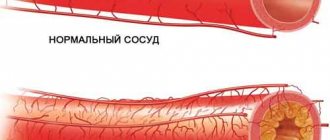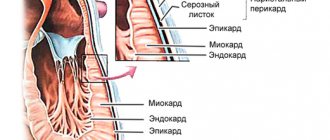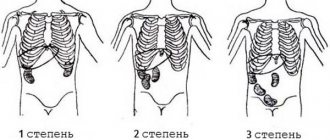Home page » Terms » Neurasthenia - what is it?
Author of the article: Alexander Firtsev
Internet marketer, editor of the site “In an accessible language” Date of publication: 06/18/2017
Neurasthenia (F48.0 according to ICD-10) is a common mental disorder from the group of neuroses, which can also be referred to as “asthenic neurosis”, “astheno-neurotic syndrome” or “chronic fatigue syndrome”. There are plenty of official terms, definitions, articles and books on the Internet devoted to this disease; often on websites and forums on the Internet there are articles about neurasthenia, written, as they say, out of the blue, just for the sake of making money; information from such articles introduces ordinary users to delusion.
To write this article, we studied materials from practicing psychotherapists who have confirmed their competence in this matter. Today we will try to tell you in an accessible language about what neurasthenia is and what its possible causes are.
Neurosis - what is it?
Neurosis is a combination of psychogenic disorders that have a reversible course, but last quite a long time. Symptoms of neurosis are obsessive and can manifest as hysterics, asthenic syndrome, and decreased physical and mental performance. Psychoneurosis and neurotic disorder are all synonyms for neurosis.
In adult patients, neuroses most often have an uncomplicated course. After recovery, the psyche is completely restored. This is the main difference between neurosis and psychosis. Statistical analysis indicates that about 20% of the world's population suffers from neuroses of varying severity. Depending on the specific social group, the percentage of patients may vary.
The disorder is based on a disorder of brain activity, which under normal conditions is the main adaptive mechanism of a person. As a result, the patient develops disorders in various areas: somatic and mental.
Neurosis, as a medical term, was introduced into use in 1776. It belongs to the Scottish doctor William Cullen.
Causes of neurosis
A variety of reasons can lead to neurosis. Neurosis is a consequence of certain factors or situations that traumatized the human psyche.
If neurosis develops due to the impact of a traumatic factor on the psyche, then such an effect is most often short-lived, but strong. An example of such a factor would be the death of a loved one.
If we are talking about a traumatic situation, then the impact on the psyche is long-term, chronic. An example would be conflict within a family. They are the ones who most often become the cause of the development of neuroses.
Experts identify such factors in the development of neurosis as:
- Psychological factors.
In this case, it means the characteristics and conditions of personality development, a person’s upbringing, his relationship with society, and the level of aspirations.
- Biological factors in the development of neurosis.
We are talking about disorders in the neurophysiological sphere, as well as malfunctions in the functioning of neurotransmitter systems. This leads to the patient becoming more susceptible to destructive psychogenic influences.
As practice shows, regardless of the environment and place of residence of patients with neuroses, all of them develop the disease with the same frequency as a result of the influence of the following events:
- Death or loss of a loved one.
- A serious illness, both of the person himself and his close relative.
- Divorce.
- Parting with a loved one.
- Dismissal from work.
- Loss of a large sum of money, bankruptcy, etc.
Heredity does not affect the development of neurosis. It is fair to point out that the manifestation of the disease is influenced by the environment in which a person was raised. A child who grew up in a family with neurotic parents who were prone to hysterics will copy their behavior. He will unconsciously, but independently, in the future traumatize his psyche.
Out of 1000 men, neurosis develops in 5-80 people. Out of 1000 women, 4-160 people develop the disease. Data provided by the American Psychiatric Association.
Causes of neurasthenia
The causes of neurasthenia can be very different, but psychologists sometimes especially emphasize certain situations that contribute to the development of the disorder. So, the causes of neurasthenia include:
- High workload with a large number of different tasks;
- Receiving a large amount of information of various contents. In simple words - brain clogging with constant reading of news and “hanging out” on social networks;
- The emergence of a situation of difficult choice, with significant risks for the individual;
- Low self-esteem, exaggeration of one’s shortcomings and focusing on them;
- A sharp change in life situation, sometimes even with positive changes in the usual way of life. A lot can be attributed to this point, for example, it could be the death of relatives, betrayal in the family, the birth of a child, moving from their usual place of residence, or even a coup in the country;
The factors listed above, according to many psychotherapists, are only a trigger button that triggers such a protective mechanism as neurasthenia. The real cause is the attitudes that you learned as a child and accepted as truth.
Most often, workaholics who work day and night, tirelessly, fall into neurasthenia, because they believe that their life will be happy or they will be loved only if they reach great heights in their career, earn a lot of money, buy a cool car, a huge one. estate, pump up huge muscles, get a model girlfriend, etc. Briefly, this belief, recorded in the subconscious of a neurasthenic, can be formulated as follows: “They will love and respect me only if I prove that I am good.” Many people at first manage to achieve a lot with this attitude, but if suddenly you fail, you have problems with work or in relationships - in general, something that does not fit into your “strategy”, then your brain triggers a defense mechanism in the form of neurosis.
Where do these strategies come from? And straight from childhood - from those situations when parents put their children in a corner for a deuce, and treat them with candy for a five, or call the child stupid or incapable of anything. The child begins to believe that he needs to prove his “goodness” and that his parents’ love is not unconditional, that they must be good and constantly “get an A” in order to be loved and happy. It is worth noting that in this case we are not talking about reasonable educational processes, but specifically about cases when parents “go too far,” perhaps without realizing it.
It is precisely such attitudes, recorded as a program in our brain, that are the causes of intrapersonal conflicts leading to neurotic reactions of the psyche.
Types of neuroses
Neurosis is not a separate disease. This term includes several disorders that can arise as a result of the negative impact of traumatic causes on a person. At the same time, he suffers from deterioration in health, he experiences mood swings, and vegetative and somatic disorders appear.
Neurasthenia
Neurasthenia is the most common form of neurosis. It is also called fatigue syndrome or nervous weakness. Neurostrain or prolonged stress can provoke neurasthenia.
Symptoms of a breakdown of nervous defense mechanisms in the form of neurasthenia can be identified as follows:
- Excessive irritability.
- Excessive excitability.
- Fast fatiguability.
- Lack of ability to control one's actions, low self-control.
- Excessive tearfulness and touchiness.
- Deterioration in performance.
- Fatigue, both mentally and physically.
- Absent-mindedness. Lack of ability to concentrate.
- Deterioration of sleep.
- Lack of appetite.
- Apathy.
- Lack of emotions regarding everything that happens around.
Hysterical neurosis
This disorder has negative manifestations on the part of the autonomic system. These include:
- Nausea.
- Vomit.
- Fainting conditions.
- Hand tremors, tremors in limbs.
- Blepharospasm.
- Deterioration of sensitivity in various parts of the body.
- Loss of vision and hearing, which develop only in the acute phase of hysteria.
- Pain in various parts of the body.
People with hysterical neurosis try with all their might to attract the attention of loved ones and doctors. Their psyche is extremely unstable, characterized by rapid mood changes. A person goes from strong laughter to sobs in a few minutes.
People who are more prone to hysterical neurosis:
- Self-hypnosis and easily suggestible people.
- Impressionable and overly sensitive people.
- People with unstable mental health.
- People who strive to attract the attention of others.
Hysterical neurosis has a similar clinical picture to some other diseases. Therefore, it is important to differentiate it from schizophrenia, central nervous system tumors, and encephalopathy, which develops after injuries.
Obsessive-compulsive disorder
With this type of neurosis, a person experiences obsessive thoughts and ideas. He is haunted by phobias that he is unable to cope with. Therefore, such a neurosis is called phobic.
The main symptom of the disorder is fear that arises from repeated unpleasant situations.
An example of obsessive-compulsive neurosis is the following situation: a person loses consciousness on the street, which leads to the formation of a fear of subsequent repetition of fainting. Subsequently, the patient develops a fear of death, serious illness, etc.
Depressive neurosis
Depressive neurosis is a consequence of long-term depression. A person suffers from insomnia, stops enjoying life, and is always in a bad mood.
Other symptoms of the disorder include:
- Malfunctions of the heart.
- Dizziness.
- Tearfulness.
- Increased sensitivity.
- Digestive disorders.
- Deterioration of sexual function.
Symptoms of neurasthenia
First, I would like to make it clear that neurasthenia is not madness!
Neurasthenia is a neurosis - a healthy protective reaction of the body, which, like a fire extinguisher, extinguishes the brain boiling from tension, but instead provides a number of unpleasant symptoms. It is especially important to understand this if, against the background of a disorder, you have a fear that you are going crazy. Don’t be afraid, a person doesn’t go crazy from neurasthenia, he is aware of his actions.
Emotional lability (unstable mood) and other symptoms that occur with neurasthenia are not a sign of insanity and not at all a sign of psychosis. Information that this disorder can develop into schizophrenia is extremely far from the truth.
Symptoms of astheno-neurotic syndrome are different, the most common are:
- irritability;
- increased fatigue, weakness, decreased performance;
- tearfulness and excessive sensitivity;
- “neurasthenic helmet” - headaches, usually squeezing the head in a circle;
- insomnia at night and drowsiness during the day;
- disorders of the gastrointestinal tract (nausea, vomiting, abdominal pain);
- decreased or, conversely, increased appetite;
- tremor, trembling in different parts of the body, muscle tension or twitching;
- changes in blood pressure, increased heart rate;
- decreased libido;
- menstrual cycle disorders in women;
- fears and phobias, hypochondria, obsessive thoughts and obsessive actions associated with it. Basically, fears consist of fixating on unpleasant sensations in the body and exaggerating their significance. For example, with neurasthenia, there are often cases of the development of cardiophobia - the fear of dying from a heart attack, even in the absence of pathologies from the cardiovascular system but the presence of unpleasant sensations in the chest. With cardiophobia, the thought of death from a heart attack often becomes obsessive, and the obsessive action in this case is very frequent measurement of blood pressure, pulse rate and hypochondriacal “runs to the doctors.”
It should be clarified that the listed symptoms are not present at the same time, but some of them are often combined, for example, irritability is usually accompanied by insomnia and headaches.
Symptoms may be fixed and not change over time, or they may replace each other over time, for example - this month the patient was irritable, he constantly had a headache and could not really sleep at night, and next month he becomes whiny, His appetite is reduced and his stomach is constantly churning.
It is also important to note that the symptoms of neurasthenia do not pose a serious threat to health, so you should not be afraid of dying from a heart attack or stroke if your blood pressure rises 15-20 points above normal; most likely, the rise in pressure is due to increased anxiety and fears.
In the book by psychotherapist Andrei Kurpatov, “The Remedy for Fatigue,” the three phases of neurasthenia, as well as their symptoms, are described in accessible language.
Thus, Andrey Kurpatov identifies the following phases:
2.1. Equalizing (Hypersthenic neurasthenia)
At this, the mildest stage of neurasthenia, a person in some way loses priorities, ceases to distinguish the main from the secondary, and the same reaction occurs to stimuli of different significance. A loud sound or bright light can “enrage” a neurasthenic just as much as an opponent in a serious conflict.
Often in the equalizing phase of neurasthenia, a person may think that something is wrong in his life, he doesn’t like his job, it’s unclear what’s going on in his family, he wants to change something, but you don’t know how, before everything seemed to be fine, something I was interested, but now everything is boring and uninteresting. Moreover, dissatisfaction with life most likely has no basis in fact, but is dictated precisely by exhaustion of nerves, and not by the fact that life is bad.
Sometimes the feeling of dissatisfaction and “exhaustion” can develop into scandals out of the blue and emotional breakdowns. The feeling of joy becomes a very rare visitor, and constant irritation haunts him like a shadow on a sunny day. From the outside it may seem that a person is “suffering from nonsense” - then because of some little thing he decides that he urgently needs to quit this “gadhouse”, then he bursts into tears when he sees a homeless person, etc.
2.2. Paradoxical (Irritable weakness).
At the paradoxical stage of neurasthenia, a person becomes even more irritable and depressed. The paradox here is that a person does not have the energy to solve serious problems, they seem unaffordable to him, and minor failures are perceived as something terrible. The reaction to minor negative events can be very violent. A person can simply “forget” about important matters, but be upset all day long because of a remark from a boss or a bad grade from a child.
There may be a swarm of thoughts swirling in your head, usually alarming and confused; thinking about these thoughts does not lead to any results and only provokes a waste of energy, which is already left at the bottom. If, however, a significantly exhausted person begins to force himself to do some things, arguing that he has become lazy, then he can take on a whole mountain of things, frantically going through one thing after another, often without completing most of the planned plan of action.
2.3. Ultraparadoxical (Hyposthenic neurasthenia)
The ultraparadoxical or hyposthenic phase of neurasthenia is the most severe form of the disorder and the most difficult to treat. In this phase, people are more like a burnt out light bulb.
He simply exists like a vegetable, he has no strength for anything, he just moves from home to work, shows no interest in anything. There is a vacuum in his head; it is not possible for him to unravel the tangle of accumulated cases, and he may not see the need for this. It seems to him that the world around him is running at some completely different speed, unknown to him.
It is damn hard for those suffering from hyposthenic neurasthenia to concentrate on anything, it is as if they are “slowing down”, many things fly past the ears, there are no more tears and hysterics, due to the fact that there is simply not enough energy for this.
It is worth noting that a prolonged stay in a state of hyposthenic neurasthenia can lead to the disorder becoming chronic, and the development of depression is also possible - a disorder that is more difficult to treat.
It is important to note that the likelihood of transition from the mildest form to a more severe one depends on many factors, including temperament, the strength of irritating factors, the subconscious attitudes of the neurasthenic, and the level of anxiety. In some cases, recovery can occur by itself even in the equalizing phase due to a decrease in the influence of irritants; there are also cases where anxious people with a weak type of nervous system developed hyposthenic neurasthenia, bypassing irritable weakness and hypersthenic neurasthenia.
Symptoms of neurosis in adults
People with neurosis suffer from frequent mood swings and are prone to impulsive actions that are difficult to control. This affects a person’s quality of life, affecting all areas: interpersonal relationships, professional activities, self-esteem, etc.
People's memory decreases, their concentration suffers, and they get tired quickly. Moreover, fatigue is observed not only during mental or physical work, but also when engaging in favorite activities. Absent-mindedness contributes to the emergence of many problematic situations.
Main symptoms of the disease:
- Constant nervous tension.
- Feeling tired.
- Drowsiness during the day, insomnia at night.
- Closedness.
- Lack of desire to communicate with other people.
- Deterioration of appetite, or its increase, which leads to overeating.
- Deterioration of cognitive processes.
- Headaches that develop suddenly and persist for a long time.
- Fainting.
- Sudden darkening of the eyes.
- Disorientation in space.
- Pain in the heart, in the muscles, in the joints, in the stomach.
- Tremor of the limbs.
- Frequent urination.
- Increased sweating, which occurs against the background of increased nervousness.
- Deterioration of sexual function.
- Problems with self-perception. A person may have high or low self-esteem.
- Violation of priorities.
- Conflicting views.
Main characteristics of patients with neuroses:
- Mood swings.
- Uncertainty about your own actions and yourself.
- Violent emotional reaction to stress.
- Touchiness and vulnerability.
- Increased irritability.
- Tearfulness.
- Increased self-criticism.
- Suspiciousness.
- Anxiety.
- The presence of unmotivated fears.
- Distortion of the value system.
- Focus on the problem.
- Increased mental fatigue.
- Absent-mindedness, memory loss.
- Increased sensitivity to loud noises, bright lights and other stimuli.
- Sleep problems.
Symptoms of neurosis in women and men
In women, neurosis has certain characteristics. Most often, in representatives of the weaker half of humanity, the disease develops according to the asthenic type. The woman becomes irritable, her mental and physical performance deteriorates, and problems appear in the sexual sphere.
Men are diagnosed with the following types of neuroses:
- Depressive neurosis.
It is this type of disorder that occurs in men more often than others. The disease can be triggered by various external problems, for example, the inability to realize oneself in the professional sphere, the inability to adapt to changes occurring in life.
- Neurasthenia in men.
The disease manifests itself due to emotional stress, or against the background of physical fatigue. Mostly workaholics suffer from male neurasthenia.
Women and men can develop climacteric neurosis, which begins in the age period from 45 to 55 years. Its symptoms: increased irritability, lack of emotional stability, worsening sleep, disruption of internal organs, and lack of stamina.
Stages of development of neurosis
If neurosis is treated, then all the changes it causes can be eliminated. The disease leads to organic damage to the brain. Neuroses often have a long course. This largely depends on the individual characteristics of a person, as well as on how developed his adaptation mechanisms are that allow him to adapt to traumatic situations. Of no small importance is the character of a person, the degree of formation of psychological defense.
Neurosis has three stages. Each of them has a different set of symptoms:
- First stage.
The disease is just beginning to develop. A person experiences increased irritability and excessive excitability.
- Hypersthenic
or intermediate stage.
In humans, the excitability of the peripheral nervous system increases. - Hyposthenic
or final stage.
The patient is in a depressed mood all the time, drowsiness increases, he is apathetic, and shows no interest in life. This is due to severe inhibition of nervous system processes.
If neurosis is not treated, the disease will certainly affect a person’s behavior. The patient begins to understand that not everything is all right with him. Neurotic personality development occurs 6 months to 2 years from the first symptoms of the disease (if it is not treated).
Probability of cure
Neurosis is curable, because This is a disease accompanied by completely reversible dysfunctions. How long the treatment will last is determined by the doctor. It all depends on the stage of the disease and the intensity of the disorders. It is possible to cure neurosis forever if the patient is aware of the problem and wants to solve it.
Those who have already overcome the disease must follow certain rules of conduct. It is worth changing your lifestyle, choosing a more rational work schedule, monitoring your psychological state, and periodically visiting a doctor.
Diagnosis of neurosis
You can cope with neurosis if you consult a specialist. Psychologists and psychotherapists are involved in identifying and treating the disease. It is logical that the main method of treatment is psychotherapy.
A person will need to reconsider his views on life. He needs to understand that at some points he behaves or behaved inappropriately.
Making a diagnosis of neurosis is a difficult task that faces the doctor. Symptoms of the disorder are varied, and this applies to both men and women. The behavioral characteristics of people and the diversity of characters make it difficult to make a diagnosis. It is important to distinguish neurosis from other psychological disorders. It is difficult to figure out this issue on your own; the patient needs the help of a doctor.
Color technique that allows you to identify neurosis:
- The entire color spectrum is used to conduct the study. If a person suffers from neurosis, then he chooses purple, gray, black and brown. Moreover, this choice is repeated all the time.
- Hysterical neurosis can be suspected when the patient chooses 2 colors - purple and red. This clearly indicates that the patient’s self-esteem is extremely low.
A positive test result indicates a psychopathic personality. It allows you to identify chronic fatigue, anxiety, and lack of self-confidence. People suffering from neuroses do not set goals for themselves that are designed for the distant future; they are not aimed at achieving them successfully. Another sign of neurosis is dissatisfaction with one’s own appearance and the presence of serious complexes. Patients find it difficult to establish contacts with other people.
Treatment of neurosis
There are many approaches and methods for treating neuroses. However, they all come down to 2 areas: taking medications and psychotherapeutic influence. Medicines are prescribed only if the disease is severe. In other situations, it will be possible to cope with the disease using psychotherapy methods.
If nervousness does not provoke the development of somatic disorders, then doctors will recommend a radical lifestyle change to the person. It is important to stabilize the work and rest regime. At least 8 hours should be allocated for sleep. You need to plan your menu correctly, completely eliminate bad habits, and be outside more often. Stress and other situations leading to nervous tension should be kept to a minimum.
Medication correction
People with neuroses often refuse to work on themselves. They do not strive to change their lives, so drug correction is firmly integrated into the traditional treatment regimen for neuroses. However, you need to understand that taking medications will not eliminate the cause of the disorder. They only make it possible to suppress the main manifestations of neurosis. This is especially true during the acute period of experiencing any traumatic situation.
Psychotropic medications can help cope with insomnia and eliminate tremors of the limbs. However, they cannot be taken for long.
Medicines that can be prescribed to patients with neurosis:
- Tranquilizers, such as Alprazolam or Phenozepam.
- Antidepressants – Sertraline and Fluoxetine.
- Sleeping pills – Zolpidem, Zopiclone.
The effect of tranquilizers is similar to the effect of neuroleptics. At the same time, tranquilizers work somewhat differently. They promote the release of gamma-aminobutyric acid, which increases a person's susceptibility to treatment.
In the early stages of therapy, taking high doses of tranquilizers can cause a number of side effects. They boil down to nausea, increased drowsiness, and a feeling of weakness. Then these manifestations decrease and completely disappear; they do not affect the patient’s ability to work. However, prescribing tranquilizers to people whose activities involve a high concentration of attention must be done very carefully.
The most commonly prescribed drugs are benzodiazepine derivatives, these are:
- Chlordiazepoxide – Elenium and Librium.
- Diazepam (Valium, Seduxen).
- Eunoctine ((Nitrazepam, Radedorm).
- Tazepam (Oxazepam).
These medications help relieve seizures, relieve anxiety, and normalize the functioning of the autonomic nervous system. They also have a weak hypnotic effect,
Other commonly prescribed tranquilizers include Trioxazin and Andaxin (Meprobamate, Meprotan). The choice of drug should only be made by a doctor, since each of them has certain properties, indications and contraindications. It is important to take into account not only the characteristics of the course of the disease, but the individual characteristics of a particular person. Thus, some patients tolerate Trioxazine well, but have difficulty accepting Seduxen.
The starting dosage of Seduxen should not exceed 5 mg, and Librium - 10 mg. Every day it is increased by 1 or 2 tablets. The dose of Seduxen is adjusted to 10-30 mg per day, and Librium to 20-60 mg.
Antipsychotic drugs have an antipsychotic, hypnotic and sedative effect. With their help you can get rid of hallucinations. However, the main side effect of taking antipsychotics is depression. Therefore, they are prescribed only for hysterical neurosis.
Antidepressants have a pronounced calming effect. They are prescribed for neurosis, which is accompanied by phobias and increased anxiety. They are injected or taken orally.
In addition, for neuroses, nootropic drugs (Nootropil) and psychostimulants can be used. They help normalize the patient’s emotional background, increase performance, eliminate the feeling of fatigue, and give a feeling of vigor. For a while, such drugs eliminate drowsiness. Their use is indicated for patients with depressive neurosis. These drugs are prescribed with caution, as they use the body's reserve capabilities. If a person has a tendency towards psychopathy, then he may develop addiction.
Adrenaline and caffeine have some effects similar to stimulants in terms of their influence on a person's physiological capabilities. Therefore, they should be taken only in the first half of the day. These may be medications such as: Benzedrine (Phenamine, Amphetamine), Sidnocarb. Their single dose is 5-10 mg. Take medications 1 or 2 times a day.
In addition to drugs aimed at general strengthening of the body, patients with neurosis may be prescribed drugs such as:
- Pantocrine. The drug is taken before meals, 30 drops 3 times a day.
- Tincture of aralia or zamanikha. Take them 30 drops 3 times a day.
- Sterculia tincture or Leuzea extract. The drug is prescribed 20 drops 3 times a day.
- Saparal 0.05 g. The drug is prescribed 1 tablet 3 times a day.
- Eleutherococcus extract according to ? tsp 3 times a day. The drug is taken before meals, half an hour before it starts.
- Schisandra in tincture. Prescribe 20 drops 2 times a day.
- Ginseng root 0.15 g (1 tablet 3 times a day), or 25 drops 3 times a day. Take the drug one hour before meals.
If a patient has problems sleeping, they are prescribed sleeping pills in small quantities to help relieve stress.
Psychotherapy in the treatment of neurosis
The basis of treatment of neurosis is psychotherapy and hypnosis. These techniques allow the patient to create a correct picture of the world, teach him to evaluate himself as a person, and make it possible to establish cause-and-effect relationships of certain events.
Color therapy is another direction in the treatment of neuroses. Scientists believe that well-chosen colors have the same effect on the brain as vitamins do on the human body as a whole.
Recommendations:
- To reduce aggression and irritability, you need to get away from the color red.
- It is advisable to exclude black and dark blue colors in clothing. It is better if a person is surrounded by light and warm colors.
- In order to reduce psycho-emotional stress, you need to look at shades of green and blue. It is these colors that should be given preference when choosing wallpaper.
Methods to get rid of the problem
Rehabilitation for neuroses includes a whole range of measures depending on the intensity of manifestations, stage and type of disease. It is important to find the cause of neurosis. The main directions of therapy: medication and psychocorrection.
If the symptoms of exacerbation of neurosis do not include somatic dysfunctions, patients need to change their daily routine. Adjust your diet and sleep at least 8 hours a day. An important condition is to exclude nervous overload; if this is not possible, special therapy will be required that will help correct behavioral reactions to the perception of a psychogenic stimulus.
Neurosis can be cured without antidepressants, using only corrective methods. Psychotherapy for neuroses is the main driving element.
Psychotherapy is the main method of treating neurosis
A set of restorative and general strengthening measures for the body will help to overcome pathology: breathing exercises, yoga, massage, physical therapy. In some cases, hypnosis is used. The procedure allows you to understand the true causes of pathology and correct behavior by instilling the correct attitudes.
Drug therapy
Typically, medications are used that calm the excitement in the brain centers or increase it, depending on the symptoms. Neurosis is treated with medications, but this is not the main therapy, but serves as an auxiliary tool. Treatment with drugs alone will give a short-term effect, but will not eliminate psychological blocks.
Psychotropic drugs are used for neuroses to relieve symptoms of overstrain, including tremors, insomnia, and loss of appetite. They are prescribed for a short period, due to the high likelihood of addiction and strong side effects. This category includes antidepressants and tranquilizers: Phenazepam, Sertraline. Zopiclone and Zolpidem have a hypnotic effect.
Treatment of neurosis with nootropics and vitamin complexes is also popular. Nootropics are used to restore neurotransmitter connections and improve blood circulation in the brain. Taking them stabilizes the condition of patients and increases activity. Glycine and Tenoten are prescribed. Vitamins help cells quickly restore functionality.
Light plant-based sedatives can gently relieve spasms in the brain, relax the nervous system, and improve the process of falling asleep. Most of them have a cumulative effect, so they are prescribed for a long period: 1-3 months, depending on the intensity of the symptoms. They prescribe “Valerian”, “Persen”, “Sedavit”, “Phyto Sed”.
Massage
As a result of a decrease in the activity of the nerve centers, the body muscles spasm, pain appears in the stomach, neck, and lower back. Massaging individual zones can effectively relieve spasms and restore peripheral communication between neurons. Under the influence of mechanical irritation of the subcutaneous nerve endings, metabolism improves, the blood flow is saturated with oxygen and easily enters the brain centers.
Peripheral nerve endings transmit a signal to the central nervous system to relax a certain part of the body. As a result, there is an improvement in the psycho-emotional state and an increase in the activity of the immune system.
Massage for neuroses is contraindicated when the patient does not make contact well or is in a hysterical fit.
Action plan:
- treatment of the head and collar zone - helps eliminate neck neurosis;
- treatment of the spinal region of the back - improves blood flow, breaks up salt deposits, affects biologically active points responsible for the functionality of most organ systems;
- working out the pectoral muscles, abdominal cavity, limbs - relieves swelling, eliminates muscle tension, helps fight stomach neurosis and tremors.
Yoga
Yoga for neurosis is a set of positions that help improve blood circulation.
Yoga is an auxiliary method of treating neurosis
All practices are aimed at teaching self-control, teaching you to listen to your body. It is worth considering that people with high blood pressure should choose a separate set of exercises that does not involve tilting the head down. If you ignore this recommendation, your condition may worsen significantly, even leading to a stroke.
Three types of yoga are used in treatment.
- Asanas are a set of exercises associated with breathing exercises.
- Mudras - involves psychological training with minimal load.
- Nidra is a technique that does not require physical work.
Patients can combine techniques on a daily basis. Asanas do not have to be performed every day. 3 times a week is enough.
Breathing exercises
Gymnastic exercises aimed at controlling breathing can quickly enrich the body with oxygen, relieve tension, and cope with uncontrolled motor reactions. Get into the starting position, close your eyes and imagine that when you inhale, you are filled with air, inflating like a balloon. The body swells, the stomach inflates. Having reached the maximum maximum, hold your breath for 2-3 seconds. Exhale.
Exercise therapy for neuroses improves the functionality of all systems and organs and has a positive effect on blood vessels. When you master the breathing practice, move on to the exercises. As you inhale, raise your outstretched arms, and as you exhale, begin to lower them to your sides with your palms facing down. Lock the position. Do a few side bends, stretching to your maximum capacity. After 2-3 bends, exhale sharply and lower your arms. Repeat the entire complex 10 times.
Psychotherapy
Treatment of psychasthenia involves corrective therapy. During psychotherapy sessions, the patient and the doctor review the symptoms and causes of a neurotic disorder. Learns to build a logical chain of cause-and-effect relationships and model the perception of a situation.
Treatment for men and women involves learning autogenic training that will help correct their behavior and program the brain to a certain attitude. Auto-training for neuroses uses affirmations - short phrases that contain a certain semantic load that allows you to correct your own behavior: “today I go to work and feel comfortable there” or “I am satisfied with my life”, “nothing threatens me”, “I am absolutely calm."
In addition to affirmations, anchoring is used, but this will require a detailed psychotherapeutic consultation.
Treatment of neurosis accompanied by fears and phobias is carried out using hypnotherapy and in special correction groups. In group classes, patients analyze their problems, learn to solve them, and receive homework assignments that allow them to consolidate the skills learned in class in real life.
Practical tips and recommendations on how to get out of neurosis:
- banish a bad thought;
- turn your attention to the positive aspects;
- try to do things you love that bring you pleasure;
- Restore your strength - sleep, take a walk.
Getting rid of a problem through psychocorrection allows one to achieve good results, but only on the condition that the patient actively makes contact and tries to help himself and wants to improve.











